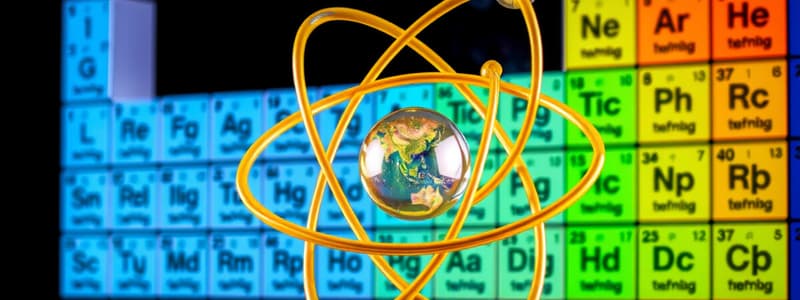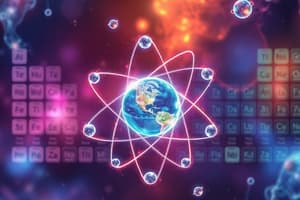Podcast
Questions and Answers
Which component of an atom carries a positive charge?
Which component of an atom carries a positive charge?
- Nucleus
- Proton (correct)
- Neutron
- Electron
What type of bond is formed by the sharing of electrons between atoms?
What type of bond is formed by the sharing of electrons between atoms?
- Metallic Bond
- Hydrogen Bond
- Ionic Bond
- Covalent Bond (correct)
Which of the following options accurately describes a mixture?
Which of the following options accurately describes a mixture?
- A fixed structure with uniform composition
- A substance that cannot be broken down
- A compound formed by chemical bonding
- A combination of substances that retain their individual properties (correct)
In the periodic table, elements in the same group share what characteristic?
In the periodic table, elements in the same group share what characteristic?
Which process involves a compound breaking down into simpler substances?
Which process involves a compound breaking down into simpler substances?
What defines an element on the periodic table?
What defines an element on the periodic table?
Which state of matter has a definite volume but takes the shape of its container?
Which state of matter has a definite volume but takes the shape of its container?
What is produced as a result of a chemical reaction?
What is produced as a result of a chemical reaction?
Which of the following describes the properties of acids?
Which of the following describes the properties of acids?
What is the key difference between an endothermic and an exothermic reaction?
What is the key difference between an endothermic and an exothermic reaction?
Which functional group is primarily associated with alcohols?
Which functional group is primarily associated with alcohols?
What is the primary measure of how much solute is dissolved in a solvent?
What is the primary measure of how much solute is dissolved in a solvent?
Which of the following statements about plasma is true?
Which of the following statements about plasma is true?
Which of the following best describes stoichiometry?
Which of the following best describes stoichiometry?
Flashcards are hidden until you start studying
Study Notes
Basic Concepts
- Matter: Anything that has mass and occupies space. Divided into:
- Elements: Pure substances that cannot be broken down.
- Compounds: Substances formed from two or more elements chemically bonded.
- Mixtures: Combinations of two or more substances that retain their individual properties.
Atomic Structure
- Atoms: Basic unit of matter, composed of:
- Protons: Positively charged particles in the nucleus.
- Neutrons: Neutral particles in the nucleus.
- Electrons: Negatively charged particles orbiting the nucleus.
- Atomic Number: Number of protons in the nucleus, defines the element.
- Mass Number: Total number of protons and neutrons in the nucleus.
Periodic Table
- Organized by increasing atomic number.
- Groups (columns): Elements with similar properties.
- Periods (rows): Elements with increasing energy levels.
Chemical Bonds
- Ionic Bonds: Formed through the transfer of electrons between atoms, resulting in charged ions.
- Covalent Bonds: Formed by the sharing of electrons between atoms.
- Metallic Bonds: Characterized by a sea of delocalized electrons around metal cations.
Chemical Reactions
- Reactants: Substances that undergo a chemical change.
- Products: New substances formed as a result of the reaction.
- Types of reactions:
- Synthesis: Two or more substances combine to form a new compound.
- Decomposition: A compound breaks down into simpler substances.
- Single Replacement: An element replaces another in a compound.
- Double Replacement: Exchange of ions between two compounds.
- Combustion: Reaction with oxygen, producing heat and light.
States of Matter
- Solid: Fixed shape and volume, particles closely packed.
- Liquid: Fixed volume but takes the shape of the container, particles are closely packed but can move past each other.
- Gas: Neither fixed volume nor shape, particles are far apart and move freely.
- Plasma: Ionized gas with free electrons and ions, conducts electricity, affected by magnetic fields.
Acids and Bases
- Acids: Substances that donate protons (H+) in a solution. Taste sour, turn blue litmus paper red.
- Bases: Substances that accept protons or donate hydroxide ions (OH-). Taste bitter, turn red litmus paper blue.
- pH Scale: Ranges from 0 to 14, measures acidity (0-7) or basicity (7-14).
Solutions
- Solute: Substance dissolved in a solvent.
- Solvent: Substance that dissolves the solute; typically a liquid.
- Concentration: Measure of how much solute is dissolved in a given volume of solvent.
Stoichiometry
- Study of quantitative relationships in chemical reactions.
- Uses balanced chemical equations to predict amounts of reactants/products.
Thermochemistry
- Study of heat changes during chemical reactions.
- Endothermic: Absorbs heat.
- Exothermic: Releases heat.
Organic Chemistry
- Study of carbon-containing compounds.
- Key functional groups include:
- Hydroxyl (-OH): Alcohols
- Carboxyl (-COOH): Acids
- Amino (-NH2): Amines
- Carbonyl (C=O): Aldehydes and ketones
Inorganic Chemistry
- Study of inorganic compounds, typically excluding carbon-based compounds.
- Focus on metals, minerals, and organometallic compounds.
Basic Concepts
- Matter comprises all substances with mass and volume, classified into elements, compounds, and mixtures.
- Elements are the simplest forms of matter, cannot be broken down, and are represented on the periodic table.
- Compounds are pure substances created from two or more elements that are chemically bonded.
- Mixtures retain the individual properties of their components and can be separated physically.
Atomic Structure
- Atoms are the fundamental building blocks of matter, consisting of protons, neutrons, and electrons.
- Protons have a positive charge and are located in the nucleus, while neutrons are neutral and also found in the nucleus.
- Electrons, negatively charged, orbit around the nucleus in energy levels.
- The atomic number indicates the number of protons in an atom, uniquely identifying each element.
- The mass number is the sum of protons and neutrons in the nucleus, providing information about the atom’s mass.
Periodic Table
- Elements in the periodic table are systematically organized by increasing atomic number.
- Groups, also known as columns, consist of elements that exhibit similar chemical properties.
- Periods, or rows, reflect elements that exhibit progressive increases in energy levels.
Chemical Bonds
- Ionic bonds form through the transfer of electrons, creating charged ions that attract each other.
- Covalent bonds result from the sharing of electrons between atoms, leading to molecule formation.
- Metallic bonds involve a "sea" of delocalized electrons surrounding positive metal ions, allowing conductivity.
Chemical Reactions
- Reactants are the starting substances that undergo change during a reaction, resulting in products, which are new substances formed.
- Synthesis reactions involve combining multiple substances to create a new compound.
- Decomposition reactions break down a compound into simpler components.
- Single replacement reactions feature one element taking the place of another in a compound.
- Double replacement reactions involve the exchange of ions between two compounds.
- Combustion reactions occur with oxygen, producing heat and light, often involving fuel.
States of Matter
- Solids have a fixed shape and volume with closely packed particles.
- Liquids maintain a fixed volume but adapt to the shape of their container, with particles that can slide past one another.
- Gases lack fixed shape or volume; particles are spread out and move freely.
- Plasma is an ionized state of matter with free electrons and ions, conducting electricity and responding to magnetic fields.
Acids and Bases
- Acids are substances that donate protons (H+) in solution, have a sour taste, and turn blue litmus paper red.
- Bases accept protons or provide hydroxide ions (OH-), taste bitter, and turn red litmus paper blue.
- The pH scale ranges from 0 to 14, quantifying acidity (0-7) and alkalinity (7-14).
Solutions
- Solutions consist of a solute, which is dissolved, and a solvent, which dissolves the solute, typically a liquid.
- Concentration indicates how much solute is contained within a given volume of solvent.
Stoichiometry
- Stoichiometry examines the quantitative relationships in chemical reactions, using balanced equations to calculate the amounts of reactants and products.
Thermochemistry
- This field explores heat changes during chemical reactions.
- Endothermic reactions absorb heat from their surroundings, while exothermic reactions release heat.
Organic Chemistry
- Organic chemistry focuses on carbon-containing compounds and their reactions.
- Key functional groups include:
- Hydroxyl (-OH) for alcohols
- Carboxyl (-COOH) for acids
- Amino (-NH2) for amines
- Carbonyl (C=O) for aldehydes and ketones
Inorganic Chemistry
- Inorganic chemistry studies compounds that do not primarily consist of carbon, emphasizing metals, minerals, and organometallic compounds.
Studying That Suits You
Use AI to generate personalized quizzes and flashcards to suit your learning preferences.



